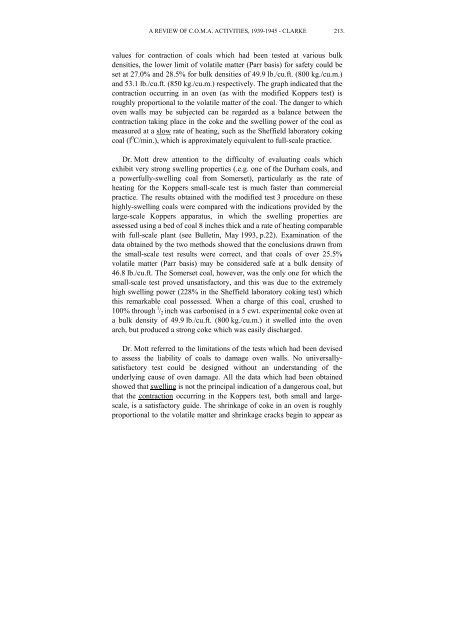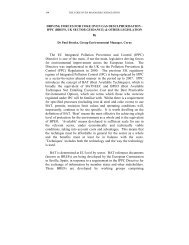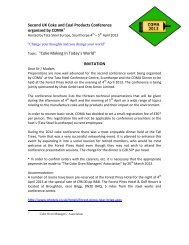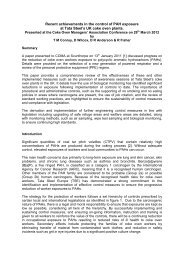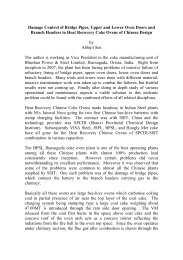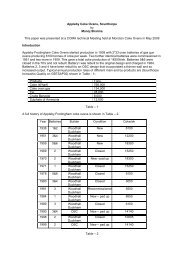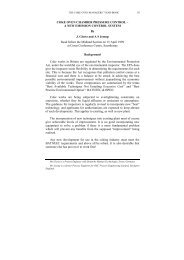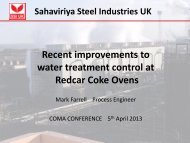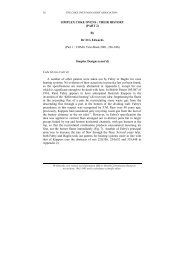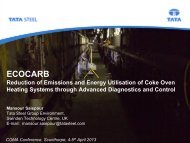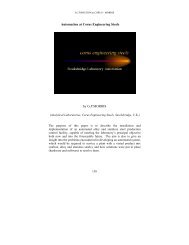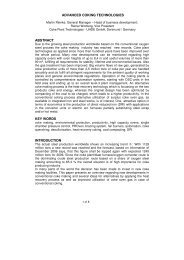CHAIRMAN'S ADDRESS - Coke Oven Managers Association
CHAIRMAN'S ADDRESS - Coke Oven Managers Association
CHAIRMAN'S ADDRESS - Coke Oven Managers Association
- No tags were found...
Create successful ePaper yourself
Turn your PDF publications into a flip-book with our unique Google optimized e-Paper software.
A REVIEW OF C.O.M.A. ACTIVITIES, 1939-1945 - CLARKE 213.values for contraction of coals which had been tested at various bulkdensities, the lower limit of volatile matter (Parr basis) for safety could beset at 27.0% and 28.5% for bulk densities of 49.9 lb./cu.ft. (800 kg./cu.m.)and 53.1 lb./cu.ft. (850 kg./cu.m.) respectively. The graph indicated that thecontraction occurring in an oven (as with the modified Koppers test) isroughly proportional to the volatile matter of the coal. The danger to whichoven walls may be subjected can be regarded as a balance between thecontraction taking place in the coke and the swelling power of the coal asmeasured at a slow rate of heating, such as the Sheffield laboratory cokingcoal (l 0 C/min.), which is approximately equivalent to full-scale practice.Dr. Mott drew attention to the difficulty of evaluating coals whichexhibit very strong swelling properties (.e.g. one of the Durham coals, anda powerfully-swelling coal from Somerset), particularly as the rate ofheating for the Koppers small-scale test is much faster than commercialpractice. The results obtained with the modified test 3 procedure on thesehighly-swelling coals were compared with the indications provided by thelarge-scale Koppers apparatus, in which the swelling properties areassessed using a bed of coal 8 inches thick and a rate of heating comparablewith full-scale plant (see Bulletin, May 1993, p.22). Examination of thedata obtained by the two methods showed that the conclusions drawn fromthe small-scale test results were correct, and that coals of over 25.5%volatile matter (Parr basis) may be considered safe at a bulk density of46.8 lb./cu.ft. The Somerset coal, however, was the only one for which thesmall-scale test proved unsatisfactory, and this was due to the extremelyhigh swelling power (228% in the Sheffield laboratory coking test) whichthis remarkable coal possessed. When a charge of this coal, crushed to100% through l / 2 inch was carbonised in a 5 cwt. experimental coke oven ata bulk density of 49.9 lb./cu.ft. (800 kg./cu.m.) it swelled into the ovenarch, but produced a strong coke which was easily discharged.Dr. Mott referred to the limitations of the tests which had been devisedto assess the liability of coals to damage oven walls. No universallysatisfactorytest could be designed without an understanding of theunderlying cause of oven damage. All the data which had been obtainedshowed that swelling is not the principal indication of a dangerous coal, butthat the contraction occurring in the Koppers test, both small and largescale,is a satisfactory guide. The shrinkage of coke in an oven is roughlyproportional to the volatile matter and shrinkage cracks begin to appear as


